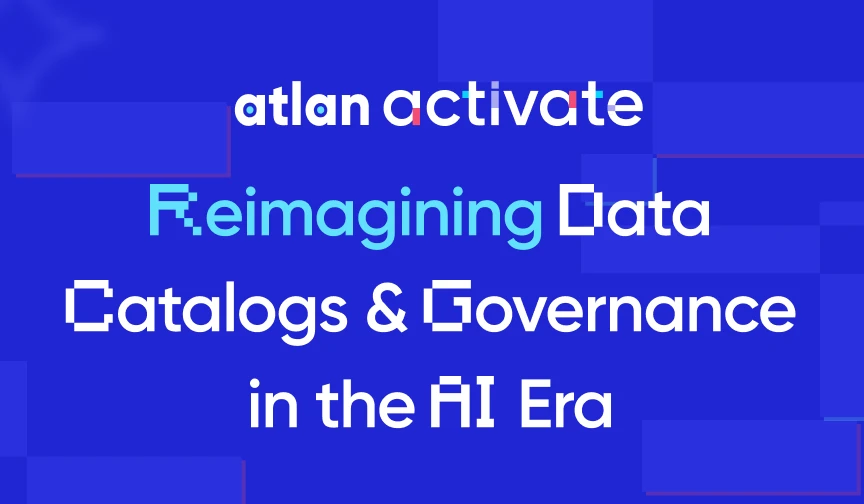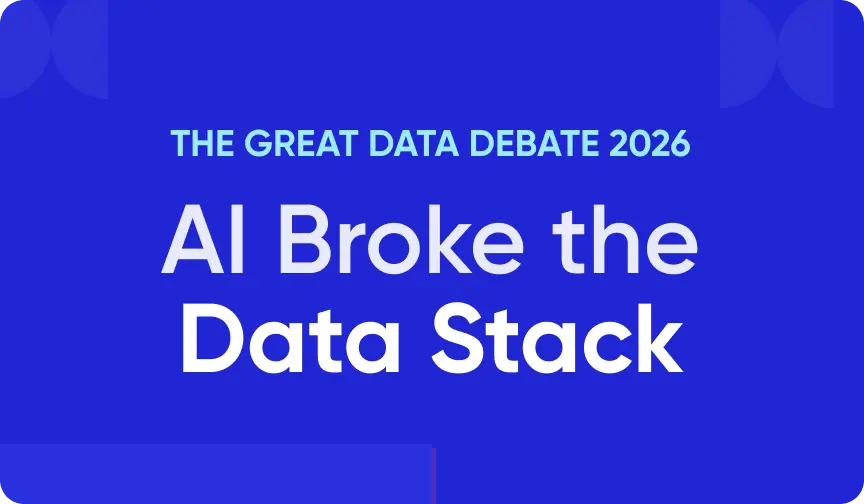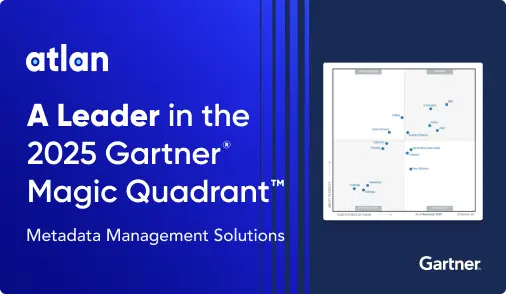Data Quality Software: Emerging Trends & Product Capabilities To Consider in 2025

Last Updated on: June 30th, 2025 | 11 min read
Unlock Your Data's Potential With Atlan

Quick Answer: What is data quality software?
Permalink to “Quick Answer: What is data quality software?”Data quality software helps organizations assess, monitor, and improve the reliability of their data. It ensures that data is accurate, complete, timely, and aligned with business expectations.
In 2025, modern data quality software is expected to support AI readiness, scale across hybrid environments, and provide shared visibility into data health for both technical and business teams.
So, how do you select the right data quality software, narrowing down your options in a crowded market?
This article lists the basic capabilities to evaluate a data quality software platform. We’ll also give you a framework for identifying your unique needs and workflows.
Table of contents
Permalink to “Table of contents”- What should you look for in data quality software in 2025? From scattered tools to a unified data quality control plane
- How can you evaluate data quality software in 2025? 5 essential aspects to consider
- Data quality software: How Atlan’s Data Quality Studio supports quality at scale
- Summing up: data quality software must build trust in 2025
- Data quality software: Frequently asked questions (FAQs)
What should you look for in data quality software in 2025? From scattered tools to a unified data quality control plane
Permalink to “What should you look for in data quality software in 2025? From scattered tools to a unified data quality control plane”Most teams start with simple tools like Great Expectations or custom SQL checks. Then they add alerting, visualization, and catalogs on top. Over time, this results in multiple tools for similar tasks, no shared context, and no clear data ownership.
As data estates grow, these fragmented tools struggle to scale.
In such a scenario, quality rules are duplicated, metadata is fragmented, and alerts don’t show downstream impact. Meanwhile, Business users lack visibility. Engineering teams manually track issues. Root cause analysis is slow, and quality doesn’t scale with growth.
Modern data quality platforms should help your data be AI-ready, and fit for critical business use cases. They must go beyond static, traditional data quality approaches, especially as organizations scale AI initiatives.
This requires data quality to be integrated across workflows, from ingestion to AI use cases.
“Data and analytics leaders should note that data quality tools do not exist alone. Instead, organizations deploy them to support a broader set of data management processes or use cases, like data integration or master data management.” - Gartner on selecting the right data quality software for your organization
So, look for data quality software platforms that act as a unified control plane – combining profiling, rules, monitoring, issue resolution, and lineage in one place.
Such tools will connect issues to owners, provide downstream impact, and bring business context into the quality workflow, thereby strengthening accountability, trust and collaboration across your organization.
With metadata-driven rules, role-based workflows, and collaboration tools in place, quality becomes a shared, proactive practice across the organization.
Also, read → Why isn’t AI delivering value yet?
How can you evaluate data quality software in 2025? 5 essential aspects to consider
Permalink to “How can you evaluate data quality software in 2025? 5 essential aspects to consider”The best data quality software for your team depends on your workflows, technical setup, and use cases. Here’s a framework that helps you assess each platform’s strengths based on practical considerations across the following areas:
- Data quality rule creation and enforcement
- Metadata and lineage integration
- Data quality monitoring and observability
- Issue triage and resolution
- Business accessibility and usability
Data quality rule creation and enforcement
Permalink to “Data quality rule creation and enforcement”Defining what “quality” means to your business is the first step. Then, teams need flexible options to enforce and refine those definitions across their pipelines.
Top-line user story:
Can we define data quality expectations for key assets in one data domain and automatically enforce rules across this domain? (This includes applying rules based on metadata like tags or classifications.)
Other user stories:
- Can analysts and engineers create rules through both visual and code-based interfaces?
- Can we enforce consistent checks for schema, freshness, completeness, and null values?
- Can we link quality rules to critical assets, classifications, or business definitions?
Capabilities to evaluate:
- Out-of-the-box rule templates for common checks (nulls, formats, ranges, duplication)
- No-code rule builder for business users and SQL/Python-based rules for technical teams
- Rule versioning and audit logs
- Rule-to-asset mapping for reuse and clarity
- Scheduled or event-based rule execution
Eventually, you should look at scaling the framework for the domain that you picked to extend data quality for the rest of your data stack.
Metadata and lineage integration
Permalink to “Metadata and lineage integration”To make data quality meaningful, it must be connected to metadata and lineage for full context and traceability.
Top-line user story:
Can we understand where a quality issue originated and how it impacts downstream assets or dashboards? Trace the lifecycle of a data issue across systems and identify risky assets?
Other user stories:
- Can we view lineage from source to consumer across pipelines?
- Can we link rules to glossary terms or sensitivity classifications?
- Can we automate tagging or policy enforcement based on metadata?
Capabilities to evaluate:
- Column-level lineage across sources, transformations, and outputs
- Impact analysis for schema or rule changes
- Active metadata ingestion from catalogs, warehouses, and orchestration tools and enrichment
- Tag-based rule triggers (ex: run mask rule on all “PII” tags)
- Lineage-aware alerts and impact reports
- Glossary integration for business term alignment
Data quality monitoring and observability
Permalink to “Data quality monitoring and observability”Monitoring is essential for proactive quality management. Look for platforms that give real-time visibility and clear context for each issue.
Top-line user story:
Can we monitor quality across tables, files, and data types with minimal setup and maximum coverage?
Other user stories:
- Can we continuously profile and assess freshness, completeness, and uniqueness across batch and streaming sources?
- Can we receive alerts and diagnostics when data fails a check?
- Can we report on historical quality trends and audit progress?
Software capabilities to look for:
- Built-in profiling across structured and unstructured formats
- Custom rules for freshness, nulls, outliers, and schema drift
- Auto-scheduled checks for critical assets
- Reporting dashboard for historical quality trends, issue frequency, and asset coverage by domain, table, or owner
- Always-on quality monitoring across sources and formats
- Real-time alerts when rules are breached
- API or webhook support for alerts into Slack, Jira, etc.
Issue triage and resolution
Permalink to “Issue triage and resolution”Even with automation, human input is required to investigate and resolve quality issues. A good platform should support collaboration and track progress.
Top-line user story:
Can we identify the root cause of a broken dashboard and quickly assign the issue to the right team with full context? (For instance, can we automatically route quality issues to Slack or Jira with context?)
Other user stories:
- Can we route issues based on asset ownership or business domain?
- Can teams view issue history and remediation steps?
- Can quality become part of day-to-day work, not a siloed task?
Capabilities to evaluate:
- Embedded collaboration with Slack, Jira, or communication and ticketing tools
- Embedded ownership and role-based permissions
- Contextual insights (affected assets, lineage, past issues)
- Status tracking, comments, and tagging within the platform
- Central dashboard to view open, resolved, and escalated issues
Business accessibility and usability
Permalink to “Business accessibility and usability”If business teams can’t use the tool, quality stays an engineering-only concern. Look for platforms designed for cross-functional adoption and low-code/no-code functions.
Top-line user story:
Can business and governance users track data quality and participate in resolving issues without writing code?
Other user stories:
- Can users explore quality scores and drill into issues without code?
- Can they create and test rules using a visual interface?
- Can decision-makers access high-level views of data health?
Capabilities to evaluate:
- No-code rule creation and test environments
- Role-based dashboards (business vs engineering views)
- Trust indicators (freshness, popularity, ownership, documentation)
- Visualization of quality trends and business impact metrics
- Interoperability with BI tools and technical catalogs
With these factors in mind, let’s look at how Atlan’s Data Quality Studio brings your entire data ecosystem together to support AI-readiness across the stack.
Data quality software: How Atlan’s Data Quality Studio supports quality at scale
Permalink to “Data quality software: How Atlan’s Data Quality Studio supports quality at scale”Atlan’s Data Quality Studio acts as a control plane for trust, helping teams manage, monitor, and resolve data quality issues across workflows. It brings together rules, lineage, context, and collaboration in one place to support data readiness for analytics and AI.
Let’s walk through the evaluation factors from the previous section to see Atlan in action.
1. Data quality rule creation and enforcement
Permalink to “1. Data quality rule creation and enforcement”Atlan lets you define what good data looks like and ensures rules are enforced consistently through automation and metadata tagging across domains.
Key capabilities include:
- No-code rule builder and SQL editor for flexible test creation
- Smart scheduling to run tests on cron, on-demand, or when fresh data arrives
- Metadata-driven rule enforcement to automatically add and propagate tags like “PII” or “restricted”
- Versioned rules with full audit history
- Rule-to-asset mapping through metadata
2. Metadata and lineage integration
Permalink to “2. Metadata and lineage integration”By connecting metadata and quality in one platform, Atlan helps teams assess root cause, enforce policies, and maintain audit readiness.
Key capabilities include:
- End-to-end column-level lineage for traceability
- Active metadata sync with catalogs, quality tools, and orchestration platforms
- Impact reports for schema and rule changes
- Tag-based policies linked to rules (e.g. auto-mask PII)
- Integration with glossary terms and business classifications
3. Data quality monitoring and observability
Permalink to “3. Data quality monitoring and observability”Atlan centralizes quality signals and connects them with metadata and ownership, so alerts don’t happen in isolation.
Key capabilities include:
- Centralized monitoring across Snowflake, Databricks, and other warehouse platforms
- Alerts linked directly to assets and owners
- Dashboards for issue trends, test coverage, and business impact
- Historical tracking of pass/fail status by domain or asset
- Compatibility with data quality and monitoring tools like Great Expectations, Monte Carlo, and Soda
4. Issue triage and resolution
Permalink to “4. Issue triage and resolution”Atlan enables quality to be operational, not reactive. Ownership is embedded into daily tools, so issues don’t fall through the cracks.
Key capabilities include:
- Issue routing into Slack, Jira, and BI tools
- Ownership assignment for faster resolution
- Enriched context with asset details, lineage, and related issues
- Activity log and resolution status tracking
- Integration with existing data workflows, tools, and systems – metadata stores, MDM tools, BI platforms, ingestion pipelines, and more
5. Business accessibility and usability
Permalink to “5. Business accessibility and usability”Atlan helps teams communicate what quality means, and gives everyone a shared view of data reliability and usefulness. So, teams across data, business, and governance use the platform without friction.
Key capabilities include:
- Data trust signals, such as freshness, documentation, popularity
- Business-friendly dashboards and no-code rule builders
- Support for data contracts to formalize expectations
- Reporting Center for test coverage, issue history, and quality trends at a glance
- Role-based access and user views tailored by domain, persona, purpose
Summing up: data quality software must build trust in 2025
Permalink to “Summing up: data quality software must build trust in 2025”In 2025, data quality software is a trust layer that connects systems, workflows, and people. The best platforms don’t just profile tables or catch errors, but instead, integrate with your metadata, automate quality checks, route issues to the right teams, and make data usability clear for everyone.
As your data stack grows and AI becomes a business priority, you need software that scales with you. Start by mapping your workflows, use cases, and bottlenecks. Then pick a platform that brings context, automation, and collaboration together to turn data quality from a checklist into a shared, operational practice.
Data quality software: Frequently asked questions (FAQs)
Permalink to “Data quality software: Frequently asked questions (FAQs)”1. What is data quality software used for?
Permalink to “1. What is data quality software used for?”Data quality software helps organizations assess, monitor, and improve the reliability of their data. It checks for issues like missing values, outdated records, schema drift, and inconsistent formats, and enables teams to enforce rules and resolve problems at scale.
2. How is data quality different from data observability?
Permalink to “2. How is data quality different from data observability?”Data observability focuses on monitoring pipeline performance and system health. Data quality, on the other hand, evaluates whether the data itself is accurate, complete, and usable for business or AI use cases. The two often work together, but they solve different problems.
3. How do I know if I’ve outgrown my current toolset?
Permalink to “3. How do I know if I’ve outgrown my current toolset?”If you’re juggling multiple tools, struggling to scale rules, or your teams can’t see or fix issues easily, it may be time to move to a unified platform that offers shared context, automation, and better coverage.
4. What features should modern data quality software have?
Permalink to “4. What features should modern data quality software have?”Modern platforms should support automated rule creation, metadata integration, lineage tracing, real-time monitoring, issue triage, and collaboration workflows. They should also be usable by both technical and non-technical users.
5. Can data quality software support AI readiness?
Permalink to “5. Can data quality software support AI readiness?”Yes. AI models require high-quality, well-documented, and bias-aware data. Data quality software helps ensure that only fit-for-purpose data is used in model training, reducing the risk of poor predictions or compliance issues.
6. What role does metadata play in data quality software?
Permalink to “6. What role does metadata play in data quality software?”Metadata provides the context needed to assess and enforce data quality at scale. It helps define where data comes from (lineage), how it should be classified (e.g. PII), and who owns it. Data quality software uses metadata to apply rules automatically, trigger alerts, link issues to business terms, and assess downstream impact. Without metadata, quality checks stay siloed and lack business relevance.
Share this article
Atlan is the next-generation platform for data and AI governance. It is a control plane that stitches together a business's disparate data infrastructure, cataloging and enriching data with business context and security.
Data quality software: Related reads
Permalink to “Data quality software: Related reads”- Data Quality Explained: Causes, Detection, and Fixes
- Data Quality Framework: 9 Key Components & Best Practices for 2025
- Data Quality Measures: Best Practices to Implement
- Data Quality Dimensions: Do They Matter?
- Resolving Data Quality Issues in the Biggest Markets
- Data Quality Problems? 5 Ways to Fix Them
- Data Quality Metrics: Understand How to Monitor the Health of Your Data Estate
- 9 Components to Build the Best Data Quality Framework
- How To Improve Data Quality In 12 Actionable Steps
- Data Integrity vs Data Quality: Nah, They Aren’t Same!
- Gartner Magic Quadrant for Data Quality: Overview, Capabilities, Criteria
- Data Management 101: Four Things Every Human of Data Should Know
- Data Quality Testing: Examples, Techniques & Best Practices in 2025
- Top Takeaways from Gartner D&A Summit 2025: A 5-Minute Recap
- Gartner Magic Quadrant for Data Quality: 2025 Insights
- Data Readiness for AI: 4 Fundamental Factors to Consider
- Role of Metadata Management in Enterprise AI: Why It Matters
- Atlan Launches Data Quality Studio for Snowflake, Becoming the Unified Trust Engine for AI
- Atlan Launches Data Quality Studio for Databricks, Activating Trust for the AI-Native Era





















